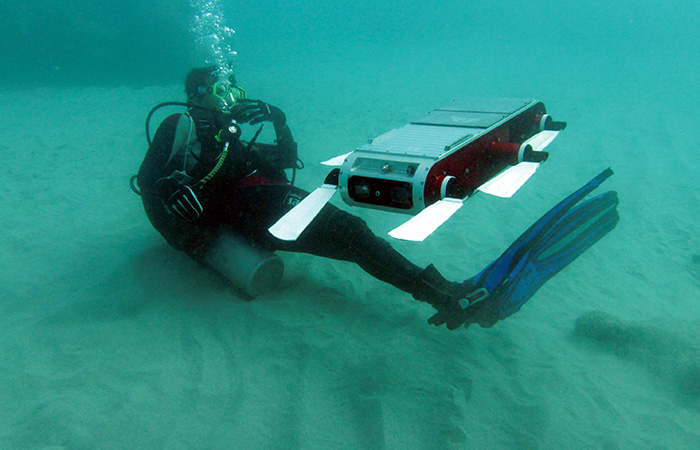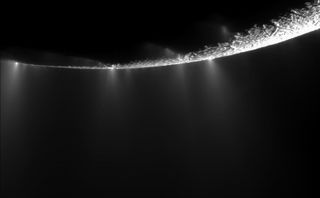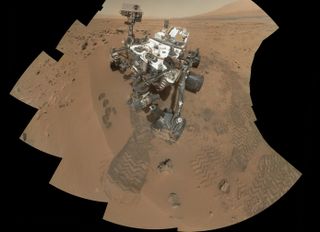How Smart Can Robotic Space Explorers Get?

If a robot plunges into the ocean of an icy moon, perhaps near Saturn or Jupiter, its main problem will be figuring out what to do next. Even at light speed, it takes hours for communications to pass back and forth to Earth.
This means any robotic explorer would need to be smart enough to avoid danger, and sophisticated enough to figure out what information to send back. These were problems puzzling Yogesh Girdhar who, as a part of his doctorate dissertation at McGill University in Montreal, redid the "brains" of an undersea robot called Aqua. An underwater robot is somewhat analogous to a space-bound robot, as both face the difficulties of communication.
"Mars is [situated] at the limit of where humans can directly control a robot to do these kinds of research," said Girdhar, who is now a postdoctoral scholar at Woods Hole Oceanographic Institution, in Woods Hole, Massachusetts. [The 6 Strangest Robots Ever Created]
"The amount of data is a problem. You can't be streaming HD video from Mars all the time, live, down to Earth," Girdhar added. "The same thing happens underwater. There are no radio waves. Because of salt water, you can only use an acoustic modem. It's very low bandwidth. You can receive data at a much higher speed from Mars than you can from a robot deep underwater."
The key to getting around that problem, Girdhar said, is having the robot train itself to recognize what is typical terrain and what is unusual. If it spots something that is rare, it is possible that whatever it saw was altered by life in some way and would require further analysis by scientists.
Part of Girdhar's work, titled "Exploring Underwater Environments with Curiosity," was presented at the Canadian Conference on Computer and Robot Vision in 2014. Girdhar worked in the laboratory of Gregory Dudek, director of McGill's computer science department.
Seeking the unusual
A typical underwater robot on Earth can do simple tasks, such as moving in a predesigned pattern that is sometimes nicknamed "mowing the lawn." Along the way, it tends to gather thousands or perhaps hundreds of thousands of pictures. How best to sift through all that information? Girdhar believes in the power of pattern recognition.
Get the Space.com Newsletter
Breaking space news, the latest updates on rocket launches, skywatching events and more!

The key is designing a robotic "brain" that can build a model of all the different things it sees in the world and what it might correspond to. Underwater, for example, a robot would expect to see a lot of sand and rock. Over time, it would build up a database of the various kinds of patterns associated with these terrain types.
Imagine that robot, however, then spotted a coral reef. Statistically speaking, it looks different and would be what the robot considers "interesting," Girdhar said. If programmed to prioritize the more unusual items it comes across, the robot could then spend more time examining that corresponding terrain and send those pictures back to Earth. [Super-Intelligent Machines: 7 Robotic Futures]
"It discovers all these things on the fly," Girdhar added. "It starts off with no information, so you don't need to feed anything into it. On a completely new planet, we have no detailed information about what kind of terrain or things exist, except for satellite imagery. So we don't want to create bias."
Brains in Barbados
Girdhar's proof-of-concept algorithms rode inside Aqua for several underwater tests in Barbados at the Bellairs Research Institute, which is a McGill University facility. Aqua is outfitted with six flippers and a wide-angle video camera, but a big difference from extraterrestrial robots is that a diver often accompanies it.

Working alongside Aqua, Girdhar observed his mechanical "brains" at work. Early results show the algorithm doing what it was supposed to do. The robot was far more interested in examining a coral head than the sand that was around it, even though the sand was piled up.
"We never told it when it started what to look for. It had no idea of anything underwater, no idea what sand is or rock is or what different corals are," Girdhar said.
Even more interesting was that the robot eventually "noticed" Girdhar and followed him — which is encouraging for any researchers on the hunt for moving, extraterrestrial life in some foreign sea, he said.
Though the robot was exploring warm waters, Girdhar said that from a computer-science perspective, nothing would really change on an icy moon. "It's more a mechanical and electrical problem, not a computer science problem. I don’t think it matters much."
The next major goal is to get a more sophisticated prototype going. Pending funding, Woods Hole Oceanographic Institute, in Woods Hole, Massachusetts, plans to put his algorithms onto one of their SeaBED autonomous robots. The machine has a better cameras, more computational power, and longer endurance thanAqua, Girdhar said, which could make it even more autonomous.
Girdhar's collaborator on the project is Woods Hole's Hanu Singh, who is also the owner/designer of the SeaBED AUV.
This story was provided by Astrobiology Magazine, a web-based publication sponsored by the NASA astrobiology program.
Follow Space.com @Spacedotcom, Facebookand Google+.
Join our Space Forums to keep talking space on the latest missions, night sky and more! And if you have a news tip, correction or comment, let us know at: community@space.com.

Elizabeth Howell (she/her), Ph.D., was a staff writer in the spaceflight channel between 2022 and 2024 specializing in Canadian space news. She was contributing writer for Space.com for 10 years from 2012 to 2024. Elizabeth's reporting includes multiple exclusives with the White House, leading world coverage about a lost-and-found space tomato on the International Space Station, witnessing five human spaceflight launches on two continents, flying parabolic, working inside a spacesuit, and participating in a simulated Mars mission. Her latest book, "Why Am I Taller?" (ECW Press, 2022) is co-written with astronaut Dave Williams.











